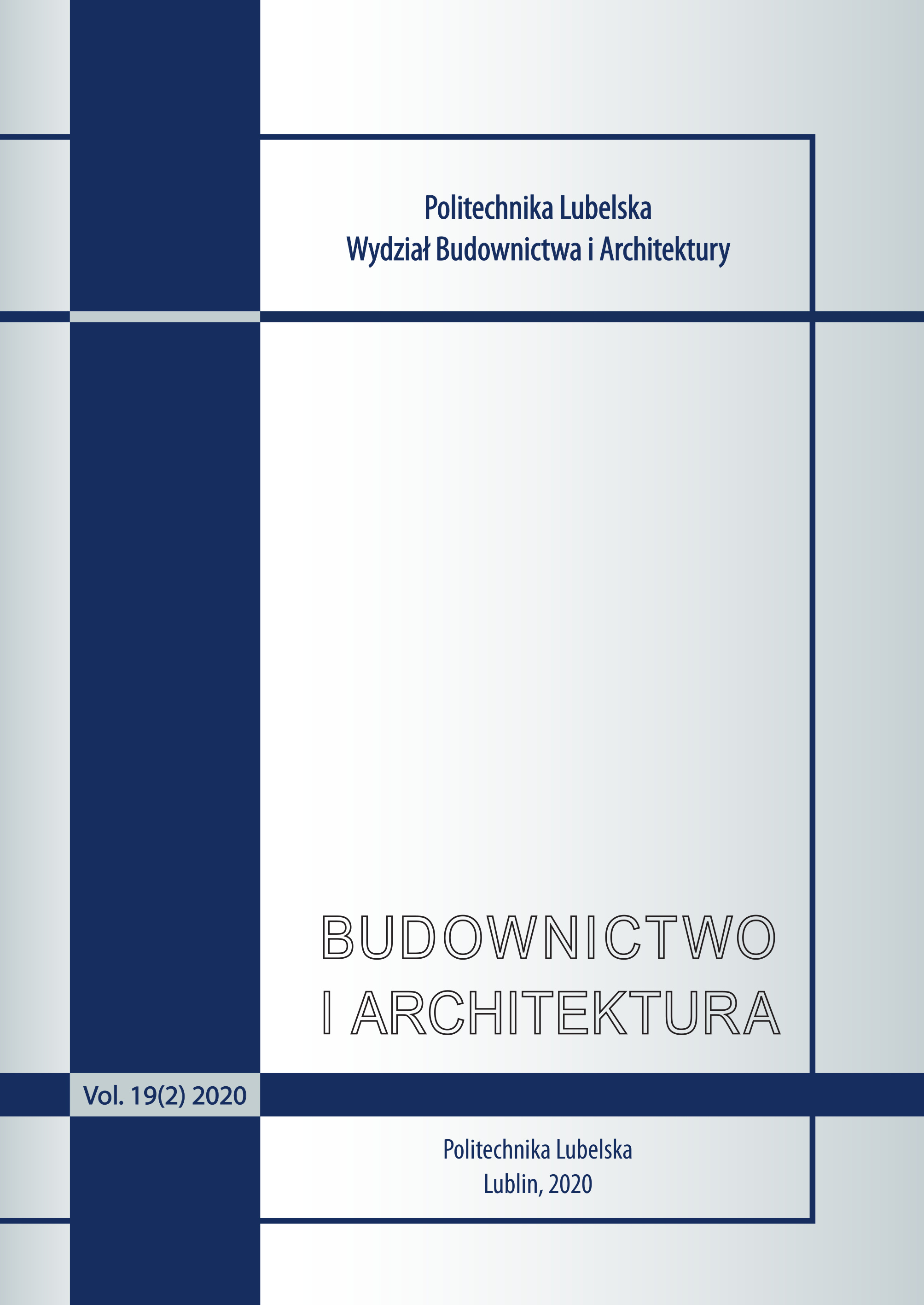Evaluation of lime plaster on masonry walls in historical buildings prior to renovation
Article Sidebar
Open full text
Issue Vol. 23 No. 4 (2024)
-
Architecture of the administrative centre of Kharkiv, the capital – laboratory for the creation of the New Man: from concept to implementation
Kateryna Didenko, Olena Gella005-023
-
Difficulties in rebuilding historic bridges after conflicts: the case of the Mosul stone bridge
Emad Ismaeel, Mahmood Alabaachi024-040
-
Dynamic similarity criteria for simple cases of buildings and structures aerodynamics
Andrzej Flaga, Łukasz Flaga041-062
-
Concrete production using marble powder and marble coarse aggregates: an analysis of mechanical properties and sustainability
Saloua Filali, Abdelkader Nasser063-081
-
Evaluation of lime plaster on masonry walls in historical buildings prior to renovation
Adrian Chajec, Anna Hoła, Jerzy Hoła, Łukasz Sadowski083-090
-
Interlocking passive brick set: the design of interlocking building components with connecting air cavities for heat dissipation and as a complement to the Heating, Ventilation, and Air Conditioning (HVAC) system
Kongphat Phaiboonnukulkij091-111
-
Methods for conducting analysis, planning, and preservation of the historical and cultural potential of urban riverside areas
Liudmyla Ruban113-127
-
Improving the properties of clay soils in foundations through compaction and the integration of fibres and cement
Abdelkader Fidjah, Mohamed Rabehi, Cheikh Kezrane, Asma Bendeb, Nour Elhouda Smain, Rachid Khalili129-149
-
The use of digital technologies in assessing the technical condition of historic structures
Bartosz Szostak, Michał Wac151-172
-
Management of energy renovation for traditional rural residential houses
Magdalena Szarejko173-190
-
Control of building safety through snow load monitoring
Roman Kinasz, Wiesław Bereza191-204
Archives
-
Vol. 24 No. 4
2025-12-16 13
-
Vol. 24 No. 3
2025-09-30 13
-
Vol. 24 No. 2
2025-06-25 13
-
Vol. 24 No. 1
2025-03-31 12
-
Vol. 23 No. 4
2025-01-02 11
-
Vol. 23 No. 3
2024-10-07 10
-
Vol. 23 No. 2
2024-06-15 8
-
Vol. 23 No. 1
2024-03-29 6
-
Vol. 22 No. 4
2023-12-29 9
-
Vol. 22 No. 3
2023-09-29 5
-
Vol. 22 No. 2
2023-06-30 3
-
Vol. 22 No. 1
2023-03-30 3
-
Vol. 21 No. 4
2022-12-14 8
-
Vol. 21 No. 3
2022-11-02 3
-
Vol. 21 No. 2
2022-08-31 3
-
Vol. 21 No. 1
2022-03-30 3
-
Vol. 19 No. 4
2020-11-02 11
-
Vol. 19 No. 3
2020-09-30 11
-
Vol. 19 No. 2
2020-06-30 10
-
Vol. 19 No. 1
2020-06-02 8
Main Article Content
DOI
Authors
Abstract
This study analysed a quantitative assessment of the adhesion of lime plasters to the substrate in a historic neo-Gothic building. The diagnostics of the plasters were conducted to preserve their large surface area due to their historical value. The use of modern non-destructive and destructive methods allowed for a significant reduction in the work required to remove the historic plaster. It was noted that only the correlation of non-destructive and destructive methods can enable an accurate determination of the necessary repair work on historic plasters. Challenges in diagnosing plasters in historic buildings are also discussed.
Keywords:
References
[1] Konca P. et al., “Możliwość stosowania tynków lekkich jako tynków renowacyjnych”, Materiały Budowlane, vol. 1, no. 9, (Sep. 2016), pp. 18-20. https://doi.org/10.15199/33.2016.09.06 DOI: https://doi.org/10.15199/33.2016.09.06
[2] Klimek B., “Research on historical mortars from the Gothic Tower in Lublin”, Teka Komisji Architektury, Urbanistyki i Studiów Krajobrazowych, vol. 18, no. 3, (Dec. 2022), pp. 18-29. https://doi.org/10.35784/TEKA.3364 DOI: https://doi.org/10.35784/teka.3364
[3] Kamiński K., “Tynki osuszające skuteczną technologią renowacji ścian gotyckiego kościoła”, Materiały Budowlane, vol. 1, no. nr 3, (Mar. 2015), pp. 24-26. https://doi.org/10.15199/33.2015.03.07 DOI: https://doi.org/10.15199/33.2015.03.07
[4] Banaszak J. and Halicka A., “Kompleksowa ocena techniczna budynku zabytkowego na przykładzie plebanii w Wojsławicach”, Budownictwo i Architektura, vol. 9, no. 2, (2011), pp. 51-68. https://doi.org/10.35784/bud-arch.2243 DOI: https://doi.org/10.35784/bud-arch.2243
[5] Trochonowicz M. et al., “Analiza porównawcza badań wilgotnościowych metodą chemiczną w stosunku do badań grawimetrycznych wybranych materiałów budowlanych”, Budownictwo i Architektura, vol. 15, no. 4, (2016), pp. 163-171. https://doi.org/10.24358/Bud-Arch_16_154_16 DOI: https://doi.org/10.24358/Bud-Arch_16_154_16
[6] Skibiński S., "Przyczyny zniszczeń elewacji Starego Ratusza w Poznaniu." Ochrona zabytków 2 (1998): 116-132.
[7] Janicka-Świerguła K., "Rekonstrukcja sufitu w sali teatralno-kinowej kasyna oficerskiego w Twierdzy Modlin", Builder, vol. 303(10), (2022), pp. 56-60. https://doi.org/10.5604/01.3001.0015.9802 DOI: https://doi.org/10.5604/01.3001.0015.9802
[8] PN-58/B-10100 “Plastering work. Standard plasters. Requirements and inspection tests”.
[9] Nogueira R. et al., “Design and behavior of traditional lime-based plasters and renders. Review and critical appraisal of strengths and weaknesses”, Cement and Concrete Composites, vol. 89, (May 2018), pp. 192-204. https://doi.org/10.1016/J.CEMCONCOMP.2018.03.005 DOI: https://doi.org/10.1016/j.cemconcomp.2018.03.005
[10] Niedostatkiewicz M. and Majewski T., “Badania doświadczalne tynków wewnętrznych”, Izolacje, vol. R. 24, no.4, (2019), pp. 82-87.
Article Details
Abstract views: 222
License

This work is licensed under a Creative Commons Attribution 4.0 International License.
Budownictwo i Architektura supports the open science program. The journal enables Open Access to their publications. Everyone can view, download and forward articles, provided that the terms of the license are respected.
Publishing of articles is possible after submitting a signed statement on the transfer of a license to the Journal.






